Impact of DEMs for Improvement Sentinel 2 Lithological Mapping Utilizing Support Vector Machine: A Case Study of Mineralized Fe-Ti-Rich Gabbroic Rocks from the South Eastern Desert of Egypt
Abstract
1. Introduction
2. Study Area and Geological Setting
3. Materials and Methods
3.1. Datasets
3.1.1. Sentinel 2 (S2)
3.1.2. ALOS-PALSAR DEM
3.2. Methods
3.2.1. Reference Geological Mapping and Feature Selection
3.2.2. Support Vector Machine (SVM)
3.2.3. Analytical Methods
4. Results
4.1. Verification of Remote Sensing Results (Using Fieldwork and Petrographic Examinations)
4.1.1. Field Investigations
4.1.2. Petrographic Examinations
5. Ferrogabbros and Their Associated Ores
5.1. Mineralogy, XRD and EDX of Fe-Ti Oxide Ores
5.2. Whole Rock Geochemistry
6. Discussion
7. Conclusions
- The study found that combining Sentinel-2 and PALSAR data improved lithological mapping compared to using Sentinel-2 alone.
- The study introduced a new, objective lithologic map of the study area (focusing on ferrogabbros due to their mineralized content) and strongly recommends blending topographical information with optical datasets as the enhancement in their outputs are mostly ensured with varied percentages depending on the nature of the lithologies, the implemented datasets and the study area.
- Both Sentinel 2 and the combined Sentinel 2–PALSAR data can be used to create reasonable lithological maps using a support vector machine. Nonetheless, incorporating PALSAR DEM with Sentinel 2 data leads to an improved lithological map.
- The resultant lithological map (using combined PALSAR DEM with Sentinel 2) introduced a well-defined distribution of ferrogabbros compared to all the previous studies over the study area.
- Analytical investigations of the ferrogabbros highlighted the presence of magnetite, titanomagnetite and hematite.
- Geochemical analysis of the ferrogabbros indicates that they were formed in the same (genetic) environment as the olivine gabbronorite, having an alkaline to calc-alkaline magma type that developed in a continental arc setting. The trace element patterns of the basic plutonic rocks that were analyzed indicate relatively high concentrations of Cr, Ni and Ba. Furthermore, the examined ferrogabbros display a negative anomaly in Ti and K.
- Gabbroic rocks within the study area could serve as a primary exploration target for their Fe-Ti oxide ores due to their higher magnetite content (50 to 55%).
Author Contributions
Funding
Data Availability Statement
Acknowledgments
Conflicts of Interest
References
- Abd El-Naby, H.; Frisch, W.; Hegner, E. Evolution of the Pan-African Wadi Haimur metamorphic sole, Eastern Desert, Egypt. J. Metamorph. Geol. 2000, 18, 639–651. [Google Scholar] [CrossRef]
- Abd El-Naby, H.H.; Frisch, W. Origin of the Wadi Haimur–Abu Swayel gneiss belt, south Eastern Desert, Egypt: Petrological and geochronological constraints. Precambrian Res. 2002, 113, 307–322. [Google Scholar] [CrossRef]
- Rowan, L.C.; Mars, J.C. Lithologic mapping in the Mountain Pass, California area using Advanced Spaceborne Thermal Emission and Reflection Radiometer (ASTER) data. Remote Sens. Environ. 2003, 84, 350–366. [Google Scholar] [CrossRef]
- Chen, X.; Warner, T.A.; Campagna, D.J. Integrating visible, near-infrared and short-wave infrared hyperspectral and multispectral thermal imagery for geological mapping at Cuprite, Nevada. Remote Sens. Environ. 2007, 110, 344–356. [Google Scholar] [CrossRef]
- Yu, L.; Porwal, A.; Holden, E.J.; Dentith, M.C. Towards automatic lithological classification from remote sensing data using support vector machines. Comput. Geosci. 2012, 45, 229–239. [Google Scholar] [CrossRef]
- Abd El-Wahed, M.; Kamh, S.; Ashmawy, M.; Shebl, A. Transpressive Structures in the Ghadir Shear Belt, Eastern Desert, Egypt: Evidence for Partitioning of Oblique Convergence in the Arabian-Nubian Shield during Gondwana Agglutination. Acta Geol. Sin.-Engl. Ed. 2019, 93, 1614–1646. [Google Scholar] [CrossRef]
- Khedr, M.Z.; Kamh, S.; Al Desouky, A.A.; Takazawa, E.; Hauzenberger, C.; Whattam, S.A.; El-Awady, A. Remote sensing and geochemical investigations of sulfide-bearing metavolcanic and gabbroic rocks (Egypt): Constraints on host-rock petrogenesis and sulfide genesis. Gondwana Res. 2023, 119, 282–312. [Google Scholar] [CrossRef]
- Abo Khashaba, S.M.; El-Shibiny, N.H.; Hassan, S.M.; Takazawa, E.; Khedr, M.Z. Application of remote sensing data integration in detecting mineralized granitic zones: A case study of the Gabal Al-Ijlah Al-Hamra, Central Eastern Desert, Egypt. J. Afr. Earth Sci. 2023, 200, 104855. [Google Scholar] [CrossRef]
- Shebl, A.; Csámer, Á. Stacked vector multi-source lithologic classification utilizing Machine Learning Algorithms: Data potentiality and dimensionality monitoring. Remote Sens. Appl. Soc. Environ. 2021, 24, 100643. [Google Scholar] [CrossRef]
- Khedr, M.Z.; Abo Khashaba, S.M.; El-Shibiny, N.H.; El-Arafy, R.A.; Takazawa, E.; Azer, M.K.; Palin, R.M. Remote sensing techniques and geochemical constraints on the formation of the Wadi El-Hima mineralized granites, Egypt: New insights into the genesis and accumulation of garnets. Int. J. Earth Sci. 2022, 111, 2409–2443. [Google Scholar] [CrossRef]
- Badawi, M.; Abdelatif, M.; Shebl, A.; Makroum, F.; Shalaby, A.; Nemeth, N. Mapping Structurally Controlled Alterations Sparked by Hydrothermal Activity in the Fatira-Abu Zawal Area, Eastern Desert, Egypt. Acta Geol. Sin.-Engl. Ed. 2022, 97, 662–680. [Google Scholar] [CrossRef]
- Abdelkader, M.A.; Watanabe, Y.; Shebl, A.; El-Dokouny, H.A.; Dawoud, M.; Csámer, Á. Effective delineation of rare metal-bearing granites from remote sensing data using machine learning methods: A case study from the Umm Naggat Area, Central Eastern Desert, Egypt. Ore Geol. Rev. 2022, 150, 105184. [Google Scholar] [CrossRef]
- Sabins, F.F. Remote sensing for mineral exploration. Ore Geol. Rev. 1999, 14, 157–183. [Google Scholar] [CrossRef]
- Shebl, A.; Abdellatif, M.; Hissen, M.; Ibrahim Abdelaziz, M.; Csámer, Á. Lithological mapping enhancement by integrating Sentinel 2 and gamma-ray data utilizing support vector machine: A case study from Egypt. Int. J. Appl. Earth Obs. Geoinf. 2021, 105, 102619. [Google Scholar] [CrossRef]
- Harris, J.R.; Grunsky, E.C. Predictive lithological mapping of Canada’s North using Random Forest classification applied to geophysical and geochemical data. Comput. Geosci. 2015, 80, 9–25. [Google Scholar] [CrossRef]
- Harris, J.R.; Ford, K.L.; Charbonneau, B.W. Application of gamma-ray spectrometer data for lithological mapping in a cordilleran environment, Sekwi Region, NWT. Can. J. Remote Sens. 2014, 35, S12–S30. [Google Scholar] [CrossRef]
- Cardoso-Fernandes, J.; Teodoro, A.C.; Lima, A.; Roda-Robles, E. Semi-Automatization of Support Vector Machines to Map Lithium (Li) Bearing Pegmatites. Remote Sens. 2020, 12, 2319. [Google Scholar] [CrossRef]
- Shebl, A.; Abdellatif, M.; Elkhateeb, S.O.; Csámer, Á. Multisource Data Analysis for Gold Potentiality Mapping of Atalla Area and Its Environs, Central Eastern Desert, Egypt. Minerals 2021, 11, 641. [Google Scholar] [CrossRef]
- Bentahar, I.; Raji, M. Comparison of Landsat OLI, ASTER, and Sentinel 2A data in lithological mapping: A Case study of Rich area (Central High Atlas, Morocco). Adv. Sp. Res. 2021, 67, 945–963. [Google Scholar] [CrossRef]
- Van der Meer, F.D.; van der Werff, H.M.A.; van Ruitenbeek, F.J.A. Potential of ESA’s Sentinel-2 for geological applications. Remote Sens. Environ. 2014, 148, 124–133. [Google Scholar] [CrossRef]
- Kuhn, S.; Cracknell, M.J.; Reading, A.M. Lithologic mapping using Random Forests applied to geophysical and remote-sensing data: A demonstration study from the Eastern Goldfields of Australia. Geophysics 2018, 83, B183–B193. [Google Scholar] [CrossRef]
- Foody, G.M.; Mathur, A. A relative evaluation of multiclass image classification by support vector machines. IEEE Trans. Geosci. Remote Sens. 2004, 42, 1335–1343. [Google Scholar] [CrossRef]
- Ham, J.S.; Chen, Y.; Crawford, M.M.; Ghosh, J. Investigation of the random forest framework for classification of hyperspectral data. IEEE Trans. Geosci. Remote Sens. 2005, 43, 492–501. [Google Scholar] [CrossRef]
- Waske, B.; Benediktsson, J.A.; Arnason, K.; Sveinsson, J.R. Mapping of hyperspectral AVIRIS data using machine-learning algorithms. Can. J. Remote Sens. 2009, 35, S106–S116. [Google Scholar] [CrossRef]
- Leite, E.P.; de Souza, C.; Leite, E.P.; de Souza, C. A Matlab Program for Textural Classification Using Neural Networks. AGUFM 2008, 2008, IN31C-1146. [Google Scholar] [CrossRef]
- Zhang, Y.; Wang, G.; Li, M.; Han, S. Automated Classification Analysis of Geological Structures Based on Images Data and Deep Learning Model. Appl. Sci. 2018, 8, 2493. [Google Scholar] [CrossRef]
- Jackisch, R.; Lorenz, S.; Kirsch, M.; Zimmermann, R.; Tusa, L.; Pirttijärvi, M.; Saartenoja, A.; Ugalde, H.; Madriz, Y.; Savolainen, M.; et al. Integrated Geological and Geophysical Mapping of a Carbonatite-Hosting Outcrop in Siilinjärvi, Finland, Using Unmanned Aerial Systems. Remote Sens. 2020, 12, 2998. [Google Scholar] [CrossRef]
- Cracknell, M.J.; Reading, A.M. Geological mapping using remote sensing data: A comparison of five machine learning algorithms, their response to variations in the spatial distribution of training data and the use of explicit spatial information. Comput. Geosci. 2014, 63, 22–33. [Google Scholar] [CrossRef]
- Kumar, C.; Chatterjee, S.; Oommen, T.; Guha, A. Automated lithological mapping by integrating spectral enhancement techniques and machine learning algorithms using AVIRIS-NG hyperspectral data in Gold-bearing granite-greenstone rocks in Hutti, India. Int. J. Appl. Earth Obs. Geoinf. 2020, 86, 102006. [Google Scholar] [CrossRef]
- Cracknell, M.J.; Reading, A.M. The upside of uncertainty: Identification of lithology contact zones from airborne geophysics and satellite data using random forests and support vector machnes. Geophysics 2013, 78, WB113–WB126. [Google Scholar] [CrossRef]
- Horrocks, T.; Holden, E.J.; Wedge, D. Evaluation of automated lithology classification architectures using highly-sampled wireline logs for coal exploration. Comput. Geosci. 2015, 83, 209–218. [Google Scholar] [CrossRef]
- Othman, A.A.; Gloaguen, R. Integration of spectral, spatial and morphometric data into lithological mapping: A comparison of different Machine Learning Algorithms in the Kurdistan Region, NE Iraq. J. Asian Earth Sci. 2017, 146, 90–102. [Google Scholar] [CrossRef]
- Pal, M.; Mather, P.M. Support vector machines for classification in remote sensing. Int. J. Remote Sens. 2005, 26, 1007–1011. [Google Scholar] [CrossRef]
- Ge, W.; Cheng, Q.; Jing, L.; Armenakis, C.; Ding, H. Lithological discrimination using ASTER and Sentinel-2A in the Shibanjing ophiolite complex of Beishan orogenic in Inner Mongolia, China. Adv. Sp. Res. 2018, 62, 1702–1716. [Google Scholar] [CrossRef]
- Wang, F.; Zhen, Z.; Wang, B.; Mi, Z. Comparative Study on KNN and SVM Based Weather Classification Models for Day Ahead Short Term Solar PV Power Forecasting. Appl. Sci. 2017, 8, 28. [Google Scholar] [CrossRef]
- Manap, H.S.; San, B.T. Lithological mapping using different classification algorithms in western antalya, turkey. Int. Multidiscip. Sci. GeoConference Surv. Geol. Min. Ecol. Manag. SGEM 2018, 18, 551–556. [Google Scholar] [CrossRef]
- Shebl, A.; Hamdy, M. Multiscale (microscopic to remote sensing) preliminary exploration of auriferous-uraniferous marbles: A case study from the Egyptian Nubian Shield. Sci. Rep. 2023, 13, 9173. [Google Scholar] [CrossRef] [PubMed]
- Liesenberg, V.; Gloaguen, R. Evaluating SAR polarization modes at L-band for forest classification purposes in eastern Amazon, Brazil. Int. J. Appl. Earth Obs. Geoinf. 2012, 21, 122–135. [Google Scholar] [CrossRef]
- Khedr, M.Z.; Al Desouky, A.A.; Kamh, S.; Hauzenberger, C.; Arai, S.; Tamura, A.; Whattam, S.A.; Morishita, T.; Lasheen, E.S.R.; El-Awady, A. Petrogenesis of Gerf Neoproterozoic carbonatized peridotites (Egypt): Evidence of convergent margin metasomatism of depleted sub-arc mantle. Lithos 2023, 450–451, 107192. [Google Scholar] [CrossRef]
- Khedr, M.Z.; El-Awady, A.; Arai, S.; Hauzenberger, C.; Tamura, A.; Stern, R.J.; Morishita, T. Petrogenesis of the ~740 Korab Kansi mafic-ultramafic intrusion, South Eastern Desert of Egypt: Evidence of Ti-rich ferropicritic magmatism. Gondwana Res. 2020, 82, 48–72. [Google Scholar] [CrossRef]
- Kharbish, S.; Eldosouky, A.M.; Amer, O. Integrating mineralogy, geochemistry and aeromagnetic data for detecting Fe–Ti ore deposits bearing layered mafic intrusion, Akab El-Negum, Eastern Desert, Egypt. Sci. Rep. 2022, 12, 15474. [Google Scholar] [CrossRef]
- EGSMA Geological Survey of Egypt. Geological Map of Egypt, Scale 1:250,000, NG 36 D Sheet; EGSMA Geological Survey of Egypt: Cairo, Egypt, 1997. [Google Scholar]
- Arivazhagan, S.; Naseer, K.A.; Mahmoud, K.A.; Arun Kumar, K.V.; Libeesh, N.K.; Sayyed, M.I.; Alqahtani, M.S.; Yousef, E.S.; Khandaker, M.U. Gamma-ray protection capacity evaluation and satellite data based mapping for the limestone, charnockite, and gneiss rocks in the Sirugudi taluk of the Dindigul district, India. Radiat. Phys. Chem. 2022, 196, 110108. [Google Scholar] [CrossRef]
- Libeesh, N.K.; Naseer, K.A.; Arivazhagan, S.; Mahmoud, K.A.; Sayyed, M.I.; Alqahtani, M.S.; Yousef, E.S. Multispectral remote sensing for determination the Ultra-mafic complexes distribution and their applications in reducing the equivalent dose from the radioactive wastes. Eur. Phys. J. Plus 2022, 137, 267. [Google Scholar] [CrossRef]
- Shebl, A.; Csámer, Á. Lithological, structural and hydrothermal alteration mapping utilizing remote sensing datasets: A case study around Um Salim area, Egypt. IOP Conf. Ser. Earth Environ. Sci. 2021, 942, 012032. [Google Scholar] [CrossRef]
- Elith, J.; Leathwick, J.R.; Hastie, T. A working guide to boosted regression trees. J. Anim. Ecol. 2008, 77, 802–813. [Google Scholar] [CrossRef] [PubMed]
- Amer, R.; Kusky, T.; Ghulam, A. Lithological mapping in the Central Eastern Desert of Egypt using ASTER data. J. Afr. Earth Sci. 2010, 56, 75–82. [Google Scholar] [CrossRef]
- Richards, J.A. Remote Sensing with Imaging Radar; Springer: Berlin/Heidelberg, Germany, 2009. [Google Scholar]
- Libeesh, N.K.; Naseer, K.A.; Arivazhagan, S.; El-Rehim, A.F.A.; ALMisned, G.; Tekin, H.O. Characterization of Ultramafic–Alkaline–Carbonatite complex for radiation shielding competencies: An experimental and Monte Carlo study with lithological mapping. Ore Geol. Rev. 2022, 142, 104735. [Google Scholar] [CrossRef]
- Green, A.A.; Berman, M.; Switzer, P.; Craig, M.D. A Transformation for Ordering Multispectral Data in Terms of Image Quality with Implications for Noise Removal. IEEE Trans. Geosci. Remote Sens. 1988, 26, 65–74. [Google Scholar] [CrossRef]
- Libeesh, N.K.; Naseer, K.A.; Mahmoud, K.A.; Sayyed, M.I.; Arivazhagan, S.; Alqahtani, M.S.; Yousef, E.S.; Khandaker, M.U. Applicability of the multispectral remote sensing on determining the natural rock complexes distribution and their evaluability on the radiation protection applications. Radiat. Phys. Chem. 2022, 193, 110004. [Google Scholar] [CrossRef]
- Luo, G.; Chen, G.; Tian, L.; Qin, K.; Qian, S.E. Minimum Noise Fraction versus Principal Component Analysis as a Preprocessing Step for Hyperspectral Imagery Denoising. Can. J. Remote Sens. 2016, 42, 106–116. [Google Scholar] [CrossRef]
- Richards, J.A.; Jia, X. Remote Sensing Digital Image Analysis; Springer: Berlin/Heidelberg, Germany, 1999; ISBN 9783540251286. [Google Scholar]
- Cortes, C.; Vapnik, V. Support-vector networks. Mach. Learn. 1995, 20, 273–297. [Google Scholar] [CrossRef]
- Othman, A.; Gloaguen, R. Improving Lithological Mapping by SVM Classification of Spectral and Morphological Features: The Discovery of a New Chromite Body in the Mawat Ophiolite Complex (Kurdistan, NE Iraq). Remote Sens. 2014, 6, 6867–6896. [Google Scholar] [CrossRef]
- Scholkopf, B.; Smola, A. Learning with Kernels: Support Vector Machines, Regularization, Optimization, and Beyond; The MIT Press: Cambridge, MA, USA, 2018. [Google Scholar]
- Chang, C.-C.; Lin, C.-J. LIBSVM: A library for support vector machines. ACM Trans. Intell. Syst. Technol. 2011, 2, 1–27. [Google Scholar] [CrossRef]
- Boser, B.E.; Guyon, I.M.; Vapnik, V.N. Training algorithm for optimal margin classifiers. In Proceedings of the Fifth Annual Workshop on Computational Learning Theory, Pittsburgh, PA, USA, 27–29 July 1992; pp. 144–152. [Google Scholar] [CrossRef]
- Shapiro, L.; Brannock, W.W. Rapid Analysis of Silicate, Carbonate and Phosphate Rocks; US Government Printing Office: Washington, DC, USA, 1962. [Google Scholar]
- El-RamlyM, F.; Akaad, M.K. The Basement Complex in the Central-Eastern Desert of Egypt, Between Latitudes 24 30′ and 25 40′ N; Geological Survey of Egypt: Cairo, Egypt, 1960. [Google Scholar]
- Sabet, A.H.; El-Gaby, S.; Zalata, A.A. Geology of the basement rocks in the northern parts of El-Shayib and Safaga sheets, Eastern Desert. Ann. Geol. Surv. Egypt 1972, 2, 111–128. [Google Scholar]
- Habib, M.E. Landsat investigation of mineralized granites in the area between Gabals El-Urf and El-Erediya due best of Safaga. In Proceedings of the Egypt 8th International Data, LARS/Purdue University, West Lafayette, IN, USA, 5 August 1982; pp. 441–446. [Google Scholar]
- Abdel-Rahman, A.F.M. Petrogenesis of Early-Orogenic Diorites, Tonalites and Post-Orogenic Trondhjemites in the Nubian Shield. J. Petrol. 1990, 31, 1285–1312. [Google Scholar] [CrossRef]
- Khalil, A.E.; El-Desoky, H.M.; Salem, A.A. Geochemistry and petrogenesis of the Neoproterozoic island arc gabbro-diorite-tonalite complexes at Wadi Abu El-Lijam and Wadi Selilab area, Central Eastern Desert, Egypt. Egypt J. Geol. 2017, 61, 1–11. [Google Scholar]
- El Shazly, E.M. The geology of the Egyptian region. In The Ocean Basins and Margins; Springer: Boston, MA, USA, 1977; Volume 4. [Google Scholar]
- El-Desoky, H.M.; Shebl, A.; Abdel-Rahman, A.M.; Fahmy, W.; El-Awny, H.; El-Sherif, A.M.; El-Rahmany, M.M.; Csámer, Á. Multiscale mineralogical investigations for mineral potentiality mapping of Ras El-Kharit-Wadi Khashir district, Southern Eastern Desert, Egypt. Egypt. J. Remote Sens. Sp. Sci. 2022, 25, 941–960. [Google Scholar] [CrossRef]
- Debon, F.; Le Fort, P. A chemical–mineralogical classification of common plutonic rocks and associations. Earth Environ. Sci. Trans. R. Soc. 1983, 73, 135–149. [Google Scholar] [CrossRef]
- Streckheisen, A.L. Classification and nomenclature of plutonic rocks. Geol. Rundsch 1974, 63, 773–786. [Google Scholar] [CrossRef]
- Miyashiro, A.; Shido, F. Tholeiitic and calc-alkalic series in relation to the behaviors of titanium, vanadium, chromium, and nickel. Am. J. Sci. 1975, 275, 265–277. [Google Scholar] [CrossRef]
- Biermanns, L. Chemical classification of gabbroic-dioritic rocks, based on TiO2, SiO2, FeOtot, MgO, K2O, Y and Zr. In Proceedings of the III International Symposium on Andean Geodynamics, Saint-Malo, France, 17–19 September 1996; pp. 547–550. [Google Scholar]
- McDonough, W.F.; Sun, S.S. The composition of the Earth. Chem. Geol. 1995, 120, 223–253. [Google Scholar] [CrossRef]
- Hamdy, M.M.; Abd El-Wahed, M.A.; Thabet, I.A. Origin of dyke swarms in Wadi El Redi-Wadi Lahami area, southern Eastern Desert of Egypt. Arab. J. Geosci. 2017, 10, 1–15. [Google Scholar] [CrossRef]
- Ahmed, A.E.A. Fusulinid marble from Wadi Heimur area, Southeastern Desert, Egypt. J. Afr. Earth Sci. 1991, 13, 397–399. [Google Scholar] [CrossRef]
- Conoco, C. Geological Map of Egypt, Scale 1:500,000-NG 36 SE Gebel Hamata, Egypt; Egyptian General Petroleum Corporation: Cairo, Egypt, 1987. [Google Scholar]
- Rankama, K.; Sahama, T.G. Geochemistry; University of Chicago Press: Chicago, IL, USA, 1964. [Google Scholar]
- Cox, P.A. Elements on Earth; Oxford University Press: Oxford, UK, 1995; 287p. [Google Scholar]
- Khedr, M.Z.; Takazawa, E.; Arai, S.; Stern, R.J.; Morishita, T.; El-Awady, A. Styles of Fe–Ti–V ore deposits in the Neoproterozoic layered mafic-ultramafic intrusions, south Eastern Desert of Egypt: Evidence for fractional crystallization of V-rich melts. J. Afr. Earth Sci. 2022, 194, 104620. [Google Scholar] [CrossRef]
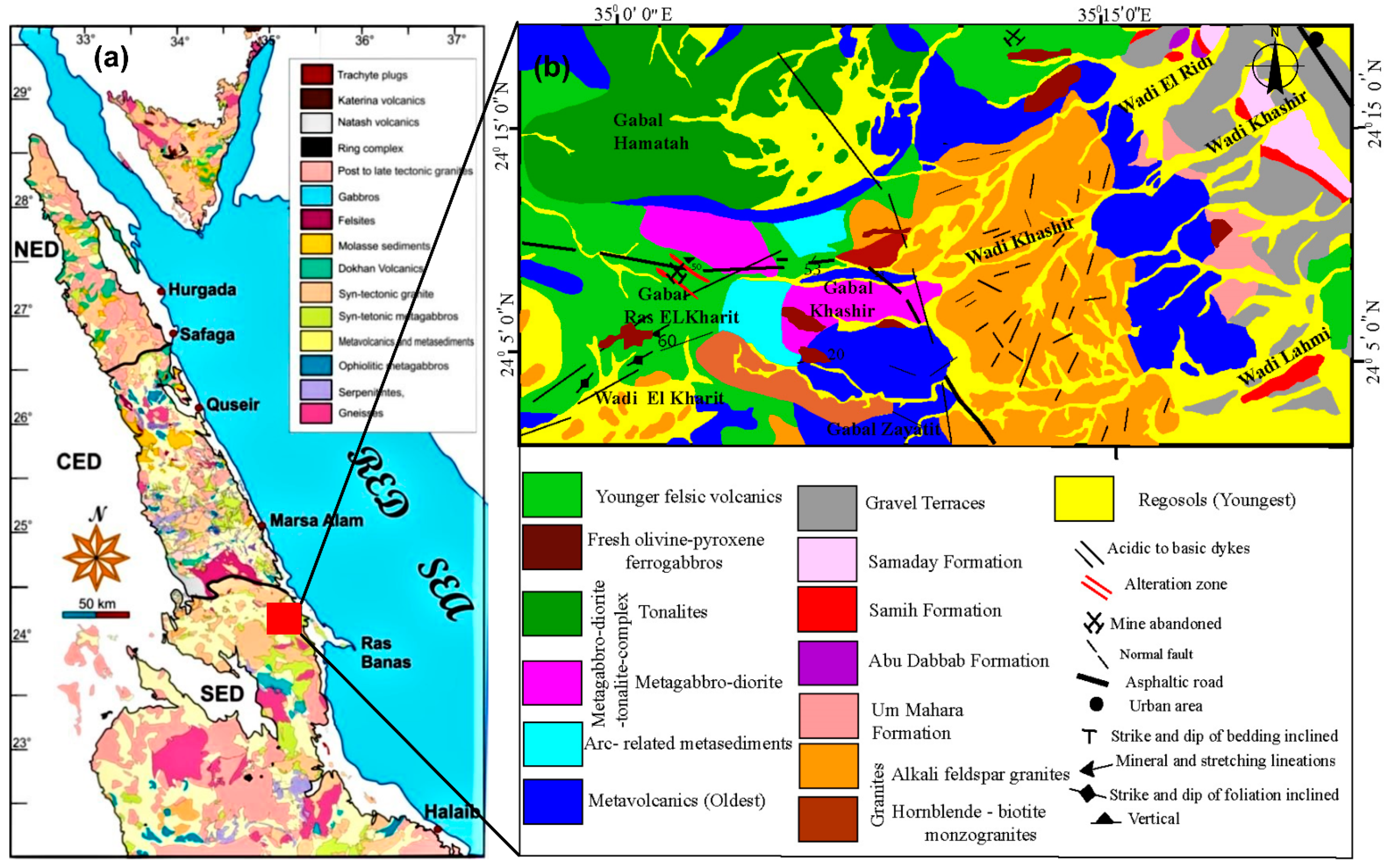
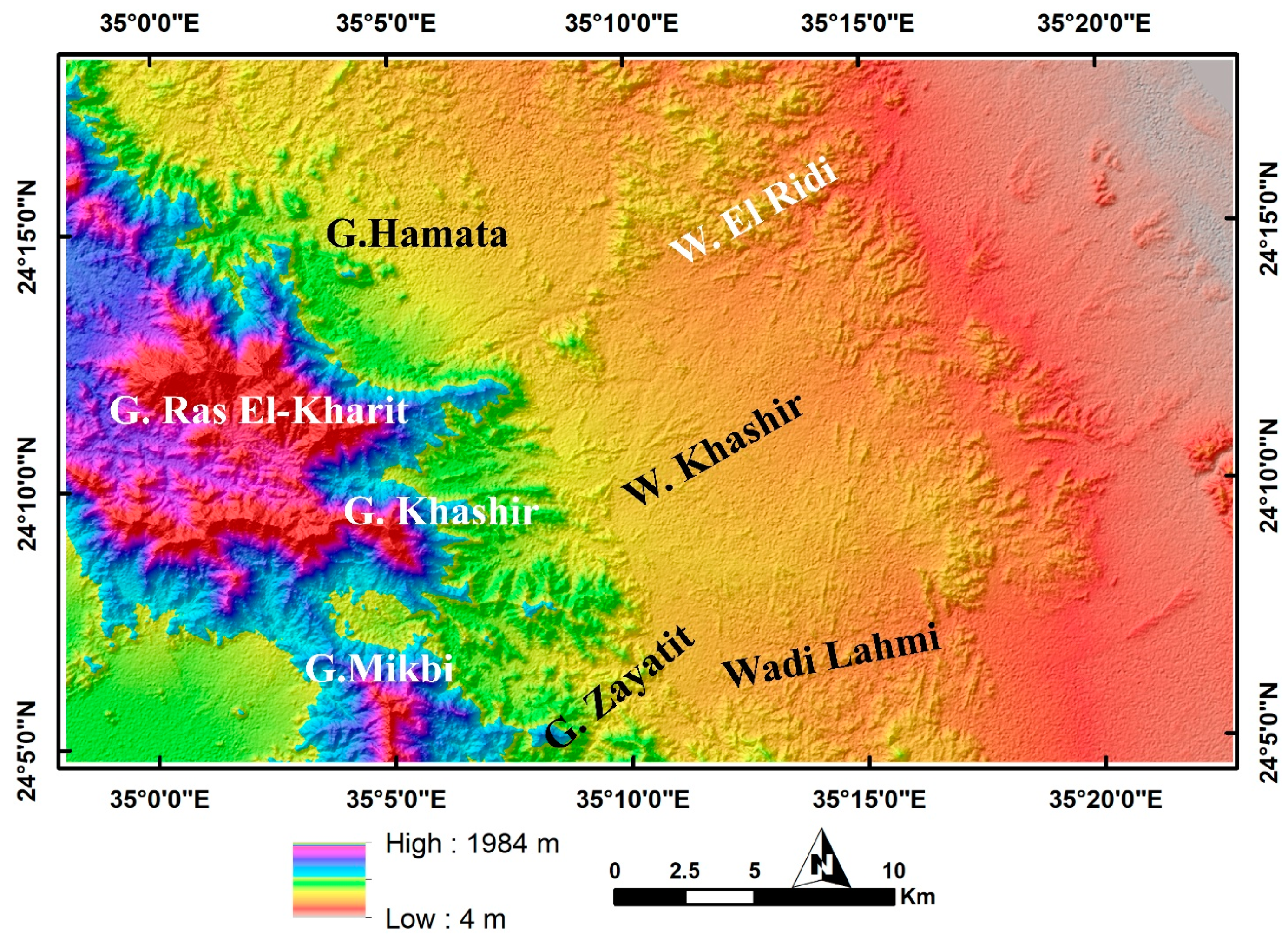

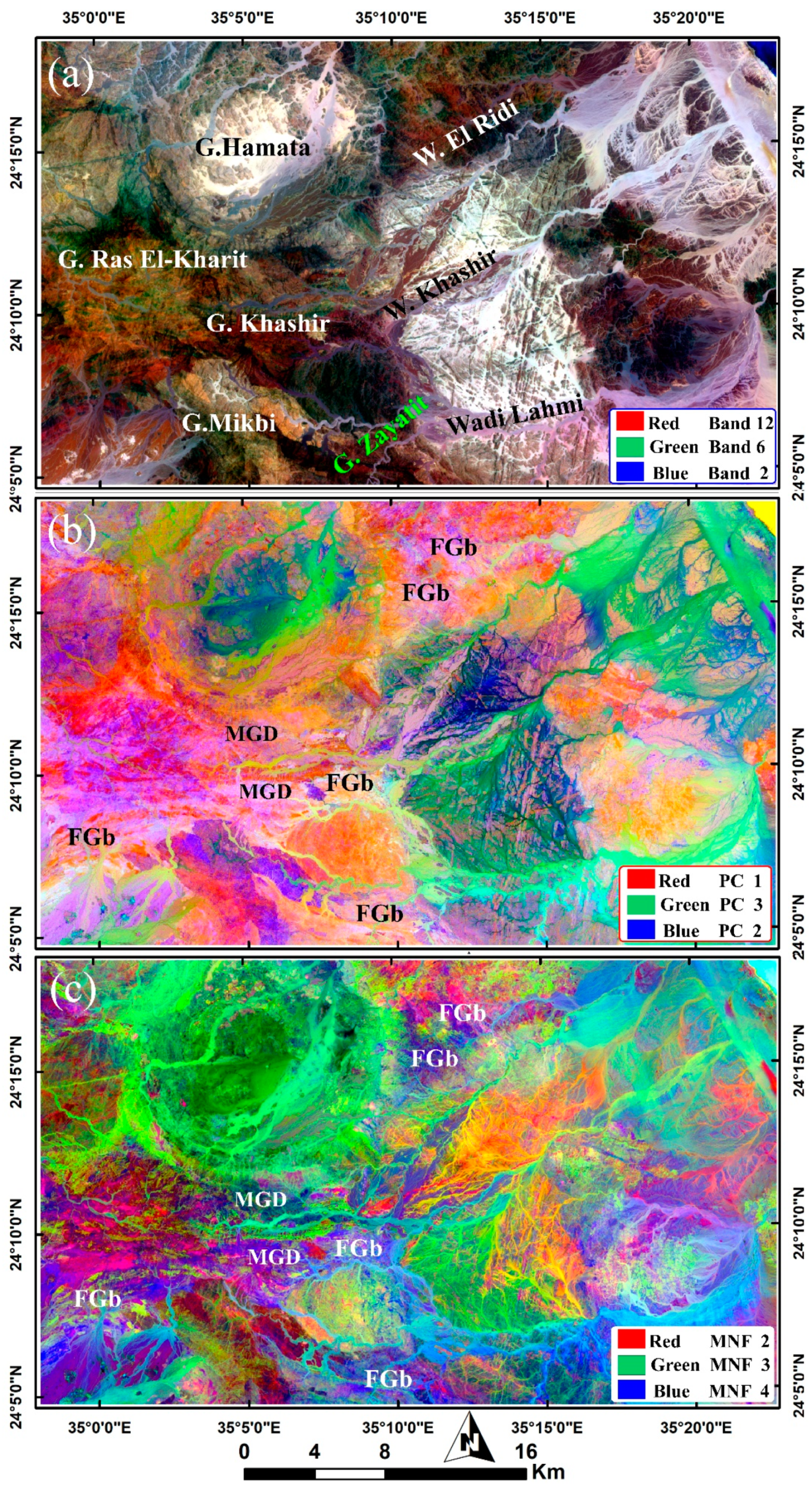

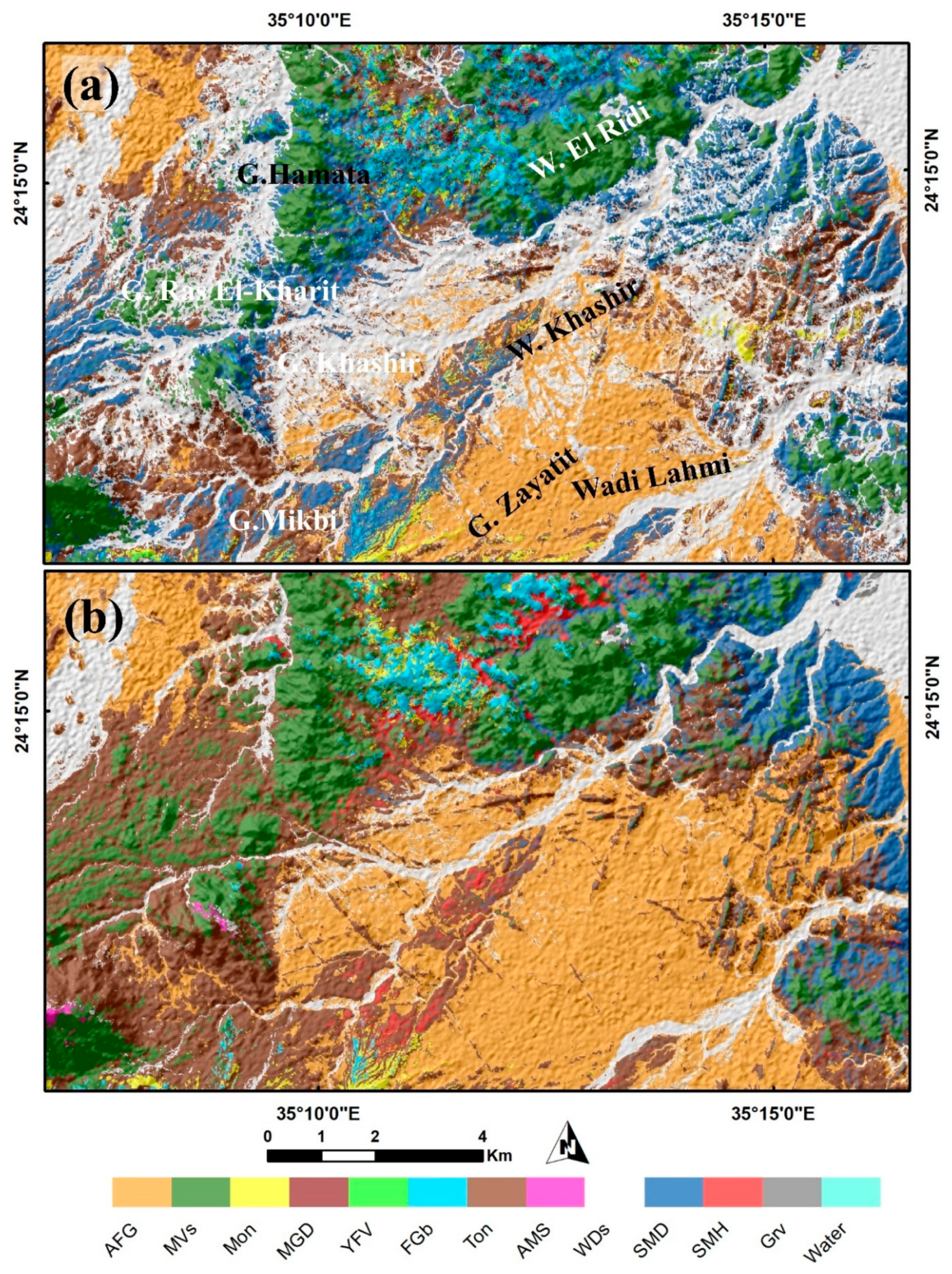
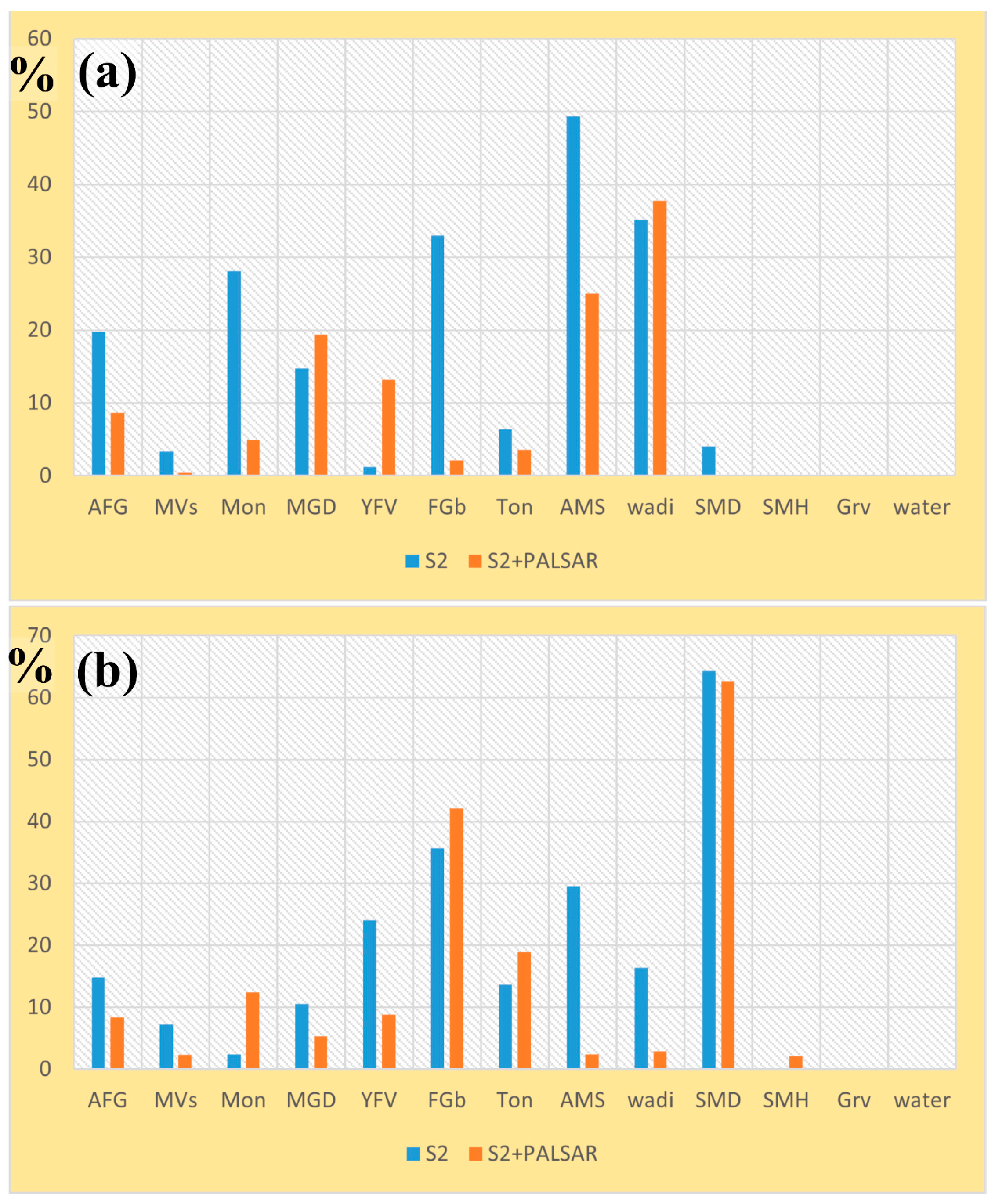

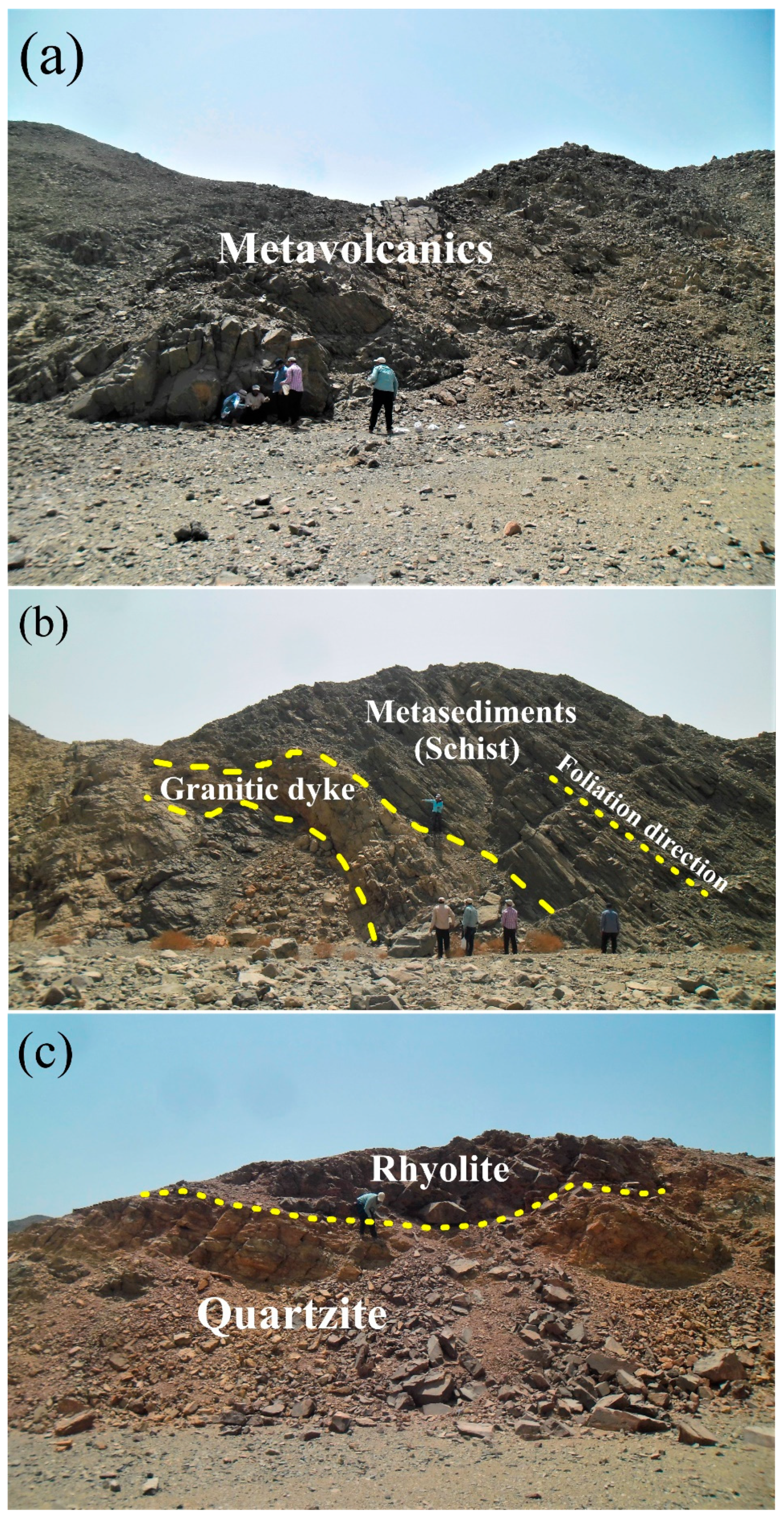
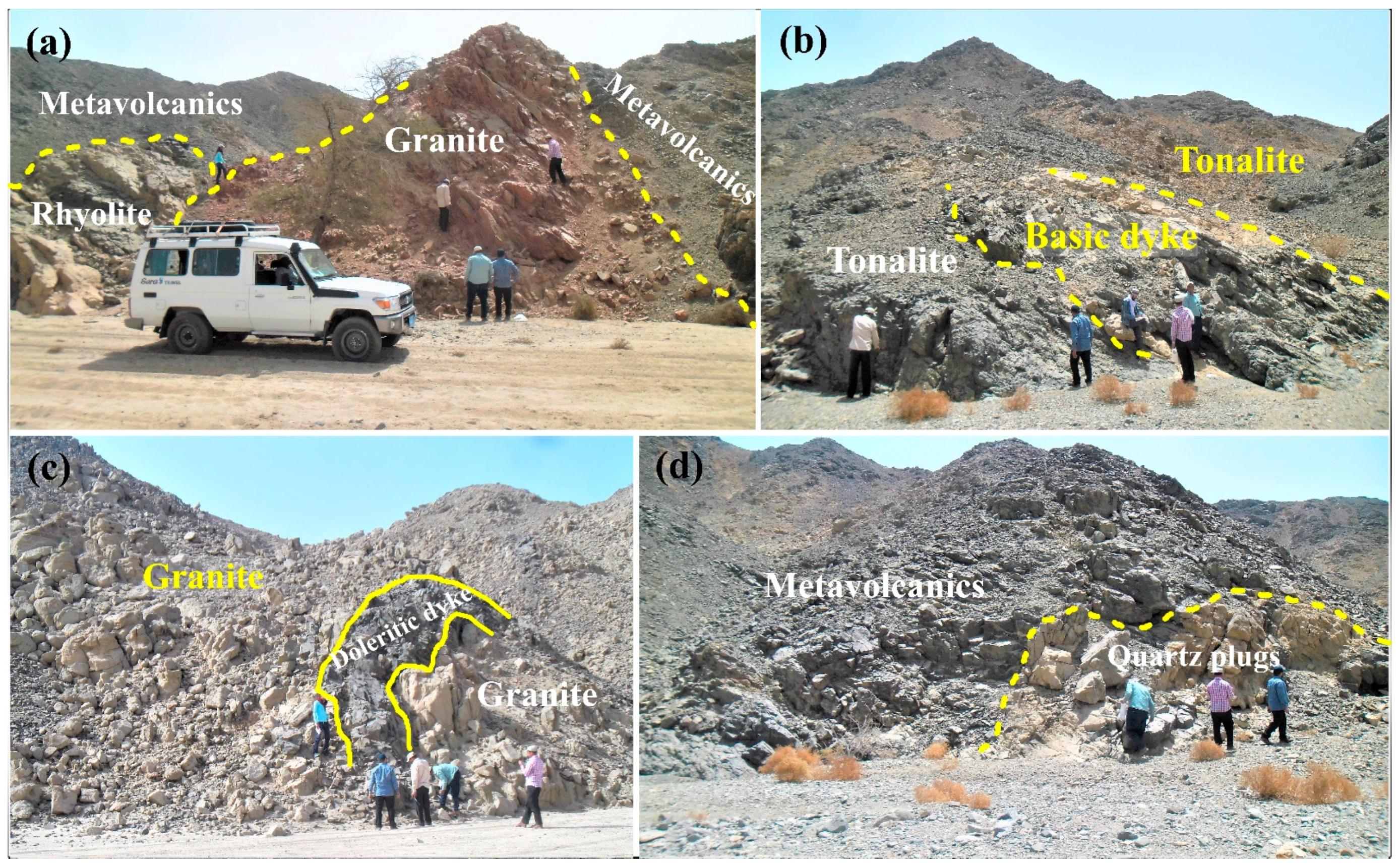


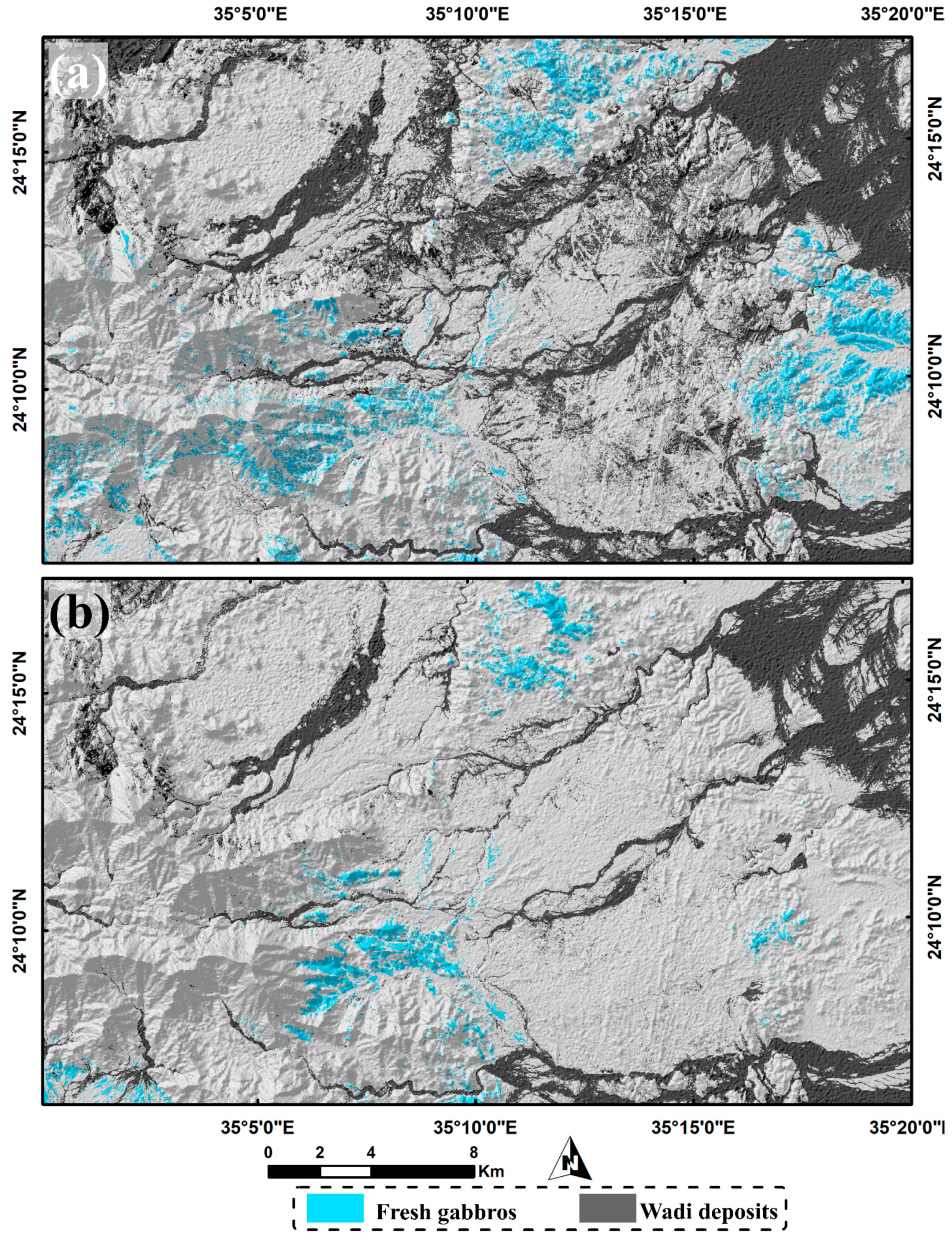
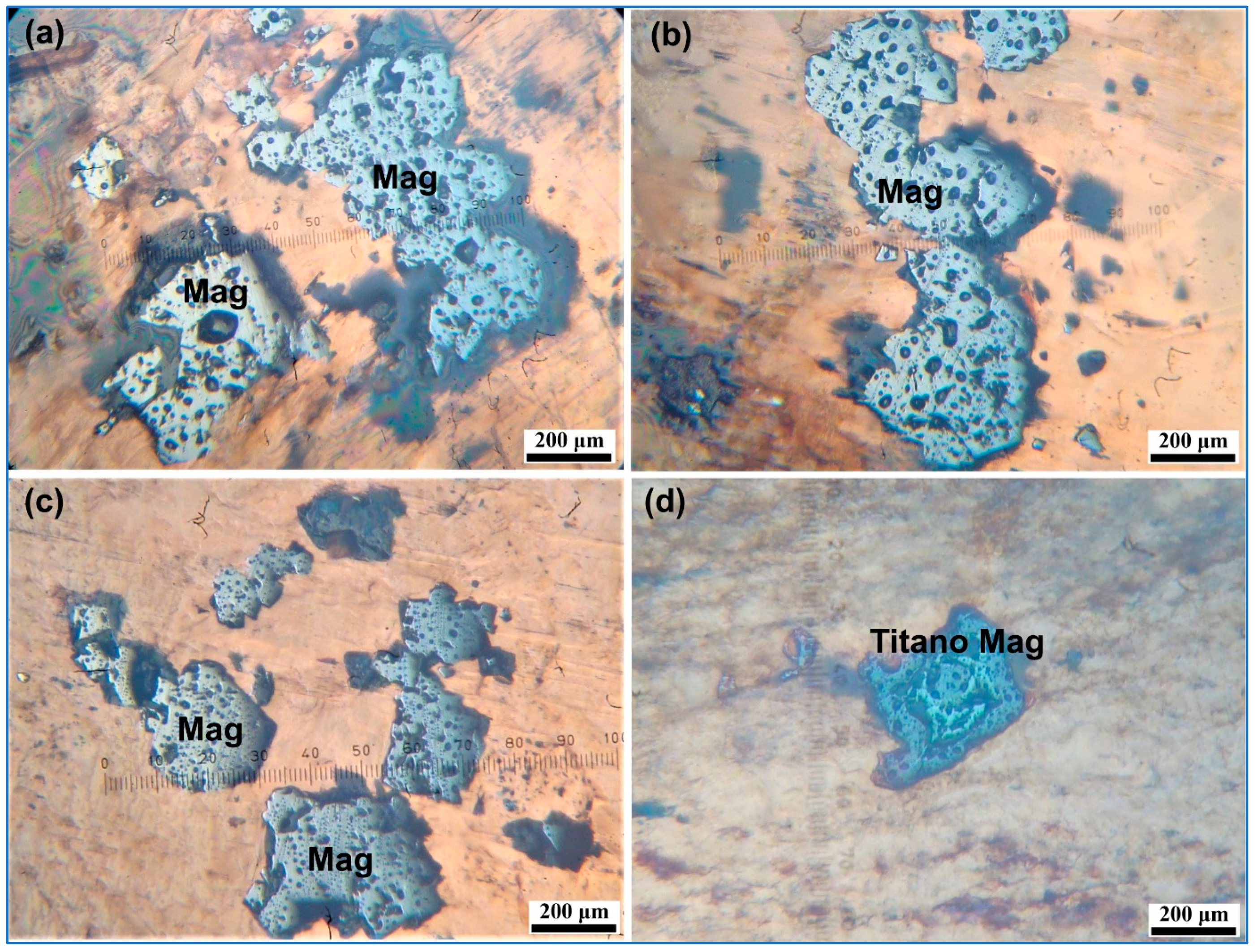
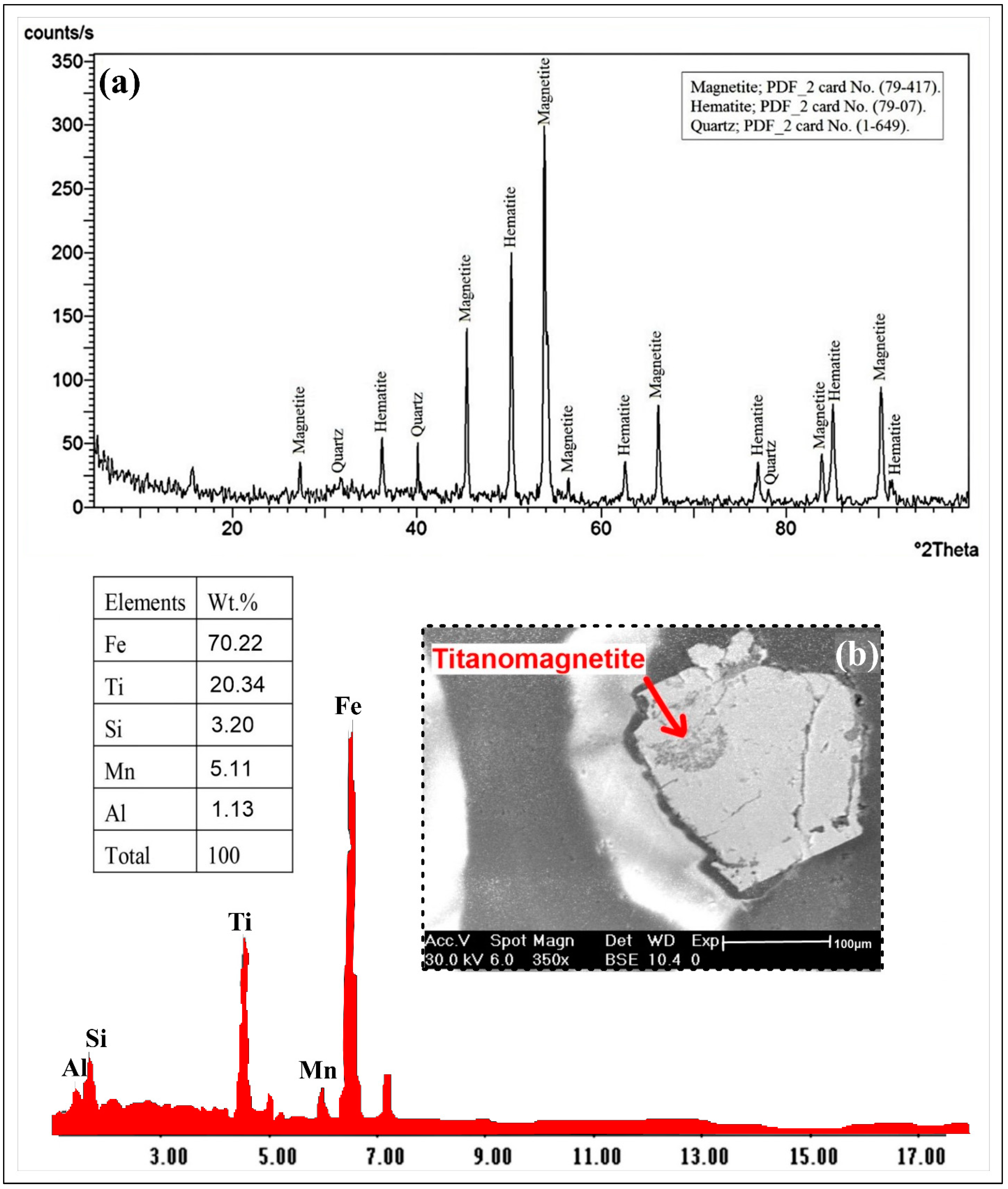
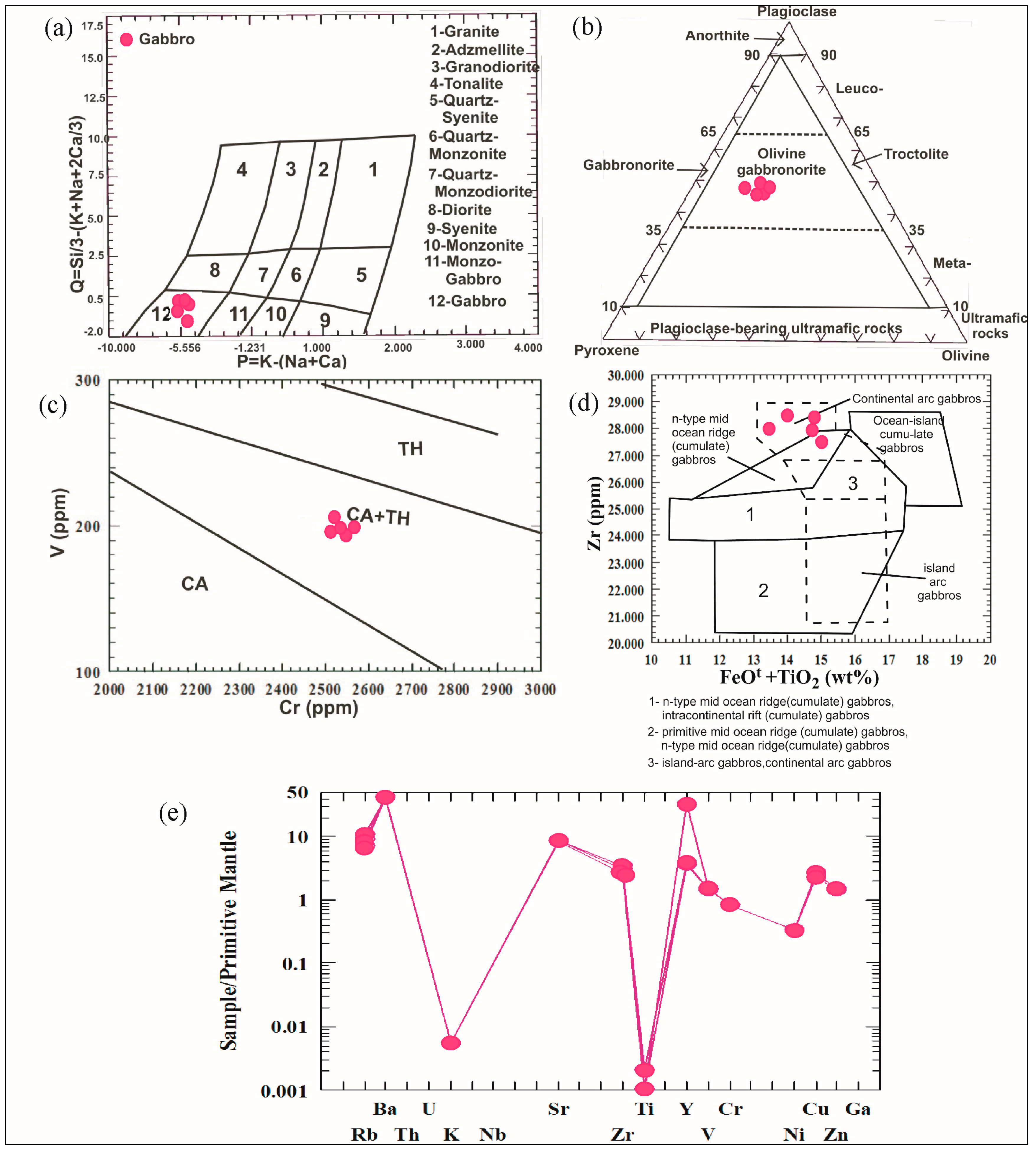
| Band | Central Wavelength (µm) | Pixel Size (m) |
|---|---|---|
| 1 | 0.443 | 60 |
| 2 | 0.490 | 10 |
| 3 | 0.560 | 10 |
| 4 | 0.665 | 10 |
| 5 | 0.704 | 20 |
| 6 | 0.740 | 20 |
| 7 | 0.782 | 20 |
| 8 | 0.842 | 10 |
| 8a | 0.865 | 20 |
| 9 | 0.945 | 60 |
| 10 | 1.375 | 60 |
| 11 | 1.610 | 20 |
| 12 | 2.190 | 20 |
| Training Data | Testing Data | |||
|---|---|---|---|---|
| Class | Pixels | % | Pixels | % |
| AFG | 2989 | 73.56 | 1074 | 26.43 |
| MVs | 2931 | 72.24 | 1126 | 27.75 |
| Mon | 2974 | 71.67 | 1175 | 28.32 |
| MGD | 3029 | 73.69 | 1081 | 26.30 |
| YFV | 3027 | 73.63 | 1084 | 26.36 |
| FGb | 571 | 75.23 | 188 | 24.76 |
| Ton | 3296 | 73.35 | 1197 | 26.64 |
| AMS | 586 | 78.55 | 160 | 21.44 |
| Wadi | 3212 | 71.28 | 1294 | 28.71 |
| SMD | 363 | 71.17 | 147 | 28.82 |
| SMH | 238 | 72.34 | 91 | 27.65 |
| Grv | 416 | 71.84 | 163 | 28.15 |
| Water | 561 | 73.14 | 206 | 26.85 |
| S2 | AFG | MVs | Mon | MGD | YFV | FGb | Ton | AMS | WDs | SMD | SMH | Grv | Water | Tot | PA | UA |
|---|---|---|---|---|---|---|---|---|---|---|---|---|---|---|---|---|
| AFG | 862 | 0 | 0 | 0 | 0 | 0 | 20 | 0 | 130 | 0 | 0 | 0 | 0 | 1012 | 80.26 | 85.18 |
| MVs | 0 | 1089 | 0 | 2 | 0 | 1 | 0 | 61 | 21 | 0 | 0 | 0 | 0 | 1174 | 96.71 | 92.76 |
| Mon | 0 | 0 | 773 | 1 | 12 | 0 | 6 | 0 | 0 | 0 | 0 | 0 | 0 | 792 | 71.91 | 97.6 |
| MGD | 0 | 0 | 51 | 922 | 1 | 57 | 0 | 0 | 0 | 0 | 0 | 0 | 0 | 1031 | 85.29 | 89.43 |
| YFV | 0 | 0 | 238 | 97 | 1071 | 0 | 3 | 1 | 0 | 0 | 0 | 0 | 0 | 1410 | 98.8 | 75.96 |
| FGb | 0 | 3 | 8 | 59 | 0 | 126 | 0 | 0 | 0 | 0 | 0 | 0 | 0 | 196 | 67.02 | 64.29 |
| Ton | 113 | 0 | 3 | 0 | 0 | 0 | 1120 | 5 | 56 | 0 | 0 | 0 | 0 | 1297 | 93.57 | 86.35 |
| AMS | 0 | 34 | 0 | 0 | 0 | 0 | 0 | 81 | 0 | 0 | 0 | 0 | 0 | 115 | 50.63 | 70.43 |
| WDs | 99 | 0 | 0 | 0 | 0 | 0 | 48 | 12 | 839 | 6 | 0 | 0 | 0 | 1004 | 64.84 | 83.57 |
| SMD | 0 | 0 | 2 | 0 | 0 | 4 | 0 | 0 | 248 | 141 | 0 | 0 | 0 | 395 | 95.92 | 35.7 |
| SMH | 0 | 0 | 0 | 0 | 0 | 0 | 0 | 0 | 0 | 0 | 163 | 0 | 0 | 163 | 100 | 100 |
| Grv | 0 | 0 | 0 | 0 | 0 | 0 | 0 | 0 | 0 | 0 | 0 | 91 | 0 | 91 | 100 | 100 |
| Water | 0 | 0 | 0 | 0 | 0 | 0 | 0 | 0 | 0 | 0 | 0 | 0 | 206 | 206 | 100 | 100 |
| Tot | 1074 | 1126 | 1075 | 1081 | 1084 | 188 | 1197 | 160 | 1294 | 147 | 163 | 91 | 206 | 8886 | OA = 84.2 | K = 0.82 |
| S2 + DEM | AFG | MVs | Mon | MGD | YFV | FGb | Ton | AMS | WDs | SMD | SMH | Grv | Water | Tot | PA | UA |
| AFG | 981 | 0 | 0 | 0 | 0 | 0 | 5 | 0 | 84 | 0 | 0 | 0 | 0 | 1070 | 91.34 | 91.68 |
| MVs | 0 | 1122 | 0 | 0 | 0 | 4 | 0 | 22 | 0 | 0 | 0 | 0 | 0 | 1148 | 99.64 | 97.74 |
| Mon | 0 | 0 | 1022 | 7 | 136 | 0 | 2 | 0 | 0 | 0 | 0 | 0 | 0 | 1167 | 95.07 | 87.57 |
| MGD | 0 | 0 | 42 | 872 | 7 | 0 | 0 | 0 | 0 | 0 | 0 | 0 | 0 | 921 | 80.67 | 94.68 |
| YFV | 0 | 0 | 0 | 74 | 941 | 0 | 17 | 0 | 0 | 0 | 0 | 0 | 0 | 1032 | 86.81 | 91.18 |
| FGb | 0 | 3 | 4 | 127 | 0 | 184 | 0 | 0 | 0 | 0 | 0 | 0 | 0 | 318 | 97.87 | 57.86 |
| Ton | 93 | 0 | 7 | 0 | 0 | 0 | 1154 | 13 | 156 | 0 | 0 | 0 | 0 | 1423 | 96.41 | 81.1 |
| AMS | 0 | 1 | 0 | 1 | 0 | 0 | 0 | 120 | 1 | 0 | 0 | 0 | 0 | 123 | 75 | 97.56 |
| WDs | 0 | 0 | 0 | 0 | 0 | 0 | 19 | 5 | 805 | 0 | 0 | 0 | 0 | 829 | 62.21 | 97.1 |
| SMD | 0 | 0 | 0 | 0 | 0 | 0 | 0 | 0 | 246 | 147 | 0 | 0 | 0 | 393 | 100 | 37.4 |
| SMH | 0 | 0 | 0 | 0 | 0 | 0 | 0 | 0 | 2 | 0 | 91 | 0 | 0 | 93 | 100 | 97.85 |
| Grv | 0 | 0 | 0 | 0 | 0 | 0 | 0 | 0 | 0 | 0 | 0 | 163 | 0 | 163 | 100 | 100 |
| Water | 0 | 0 | 0 | 0 | 0 | 0 | 0 | 0 | 0 | 0 | 0 | 0 | 206 | 206 | 100 | 100 |
| Tot | 1074 | 1126 | 1075 | 1081 | 1084 | 188 | 1197 | 160 | 1294 | 147 | 91 | 163 | 206 | 8886 | OA = 87.8 | K = 0.86 |
| Rock Units | Olivine–Pyroxene Ferrogabbros | |||||
|---|---|---|---|---|---|---|
| Sample No. | K46 | K48 | K49 | K50 | K51 | Average |
| SiO2 | 51.50 | 49.65 | 49.90 | 49.85 | 49.80 | 50.14 |
| TiO2 | 2.75 | 1.85 | 1.80 | 1.70 | 2.6 | 1.99 |
| Al2O3 | 18.50 | 16.15 | 16.50 | 16.30 | 16.22 | 16.73 |
| Fe2O3 | 1.75 | 1.49 | 1.55 | 1.45 | 1.23 | 1.49 |
| FeO | 15.74 | 13.45 | 13.94 | 13.74 | 13.89 | 14.15 |
| Fe2O3* | 17.50 | 14.95 | 15.50 | 15.19 | 15.12 | 15.6 |
| MgO | 2.10 | 5.00 | 4.00 | 4.12 | 5.13 | 4.07 |
| CaO | 4.00 | 9.50 | 7.00 | 8.12 | 8.15 | 7.35 |
| Na2O | 0.88 | 1.15 | 1.02 | 1.12 | 1.08 | 1.05 |
| K2O | 0.67 | 0.82 | 0.66 | 0.63 | 0.68 | 0.69 |
| P2O5 | 0.65 | 0.35 | 0.20 | 0.34 | 0.22 | 0.35 |
| LOI | 0.55 | 2.75 | 1.60 | 2.05 | 1.75 | 1.74 |
| Total | 99.10 | 102.2 | 98.18 | 99.42 | 99.98 | - |
| Na2O/K2O | 1.31 | 1.4 | 1.55 | 1.8 | 1.6 | 1.5 |
| Trace Elements (ppm) | ||||||
| Cr | 2443 | 2450 | 2435 | 2455 | 2470 | 2451 |
| Cu | 71 | 65 | 75 | 70 | 68 | 70 |
| Ni | 669 | 661 | 677 | 675 | 660 | 668 |
| Zn | 76 | 71 | 72 | 70 | 77 | 73 |
| Zr | 25 | 28 | 22 | 29 | 23 | 25 |
| Ga | - | - | - | - | - | - |
| Sr | 153 | 158 | 151 | 155 | 157 | 155 |
| Y | 13 | 111 | 12 | 14 | 22 | 34 |
| Rb | 4 | 6 | 5 | 7 | 5 | 5 |
| V | 191 | 197 | 187 | 198 | 180 | 191 |
| Nb | - | - | - | - | - | - |
| Pb | - | - | - | - | - | - |
| Ba | 211 | 208 | 214 | 210 | 212 | 211 |
| Rb/Sr | 0.03 | 0.038 | 0.03 | 0.05 | 0.03 | 0.04 |
| Zn/(Pb + Zn) | 1 | 1 | 1 | 1 | 1 | 1 |
Disclaimer/Publisher’s Note: The statements, opinions and data contained in all publications are solely those of the individual author(s) and contributor(s) and not of MDPI and/or the editor(s). MDPI and/or the editor(s) disclaim responsibility for any injury to people or property resulting from any ideas, methods, instructions or products referred to in the content. |
© 2023 by the authors. Licensee MDPI, Basel, Switzerland. This article is an open access article distributed under the terms and conditions of the Creative Commons Attribution (CC BY) license (https://creativecommons.org/licenses/by/4.0/).
Share and Cite
Shebl, A.; El-Desoky, H.M.; Abdel-Rahman, A.M.; Fahmy, W.; El-Awny, H.; El-Sherif, A.; El-Rahmany, M.M.; Csámer, Á. Impact of DEMs for Improvement Sentinel 2 Lithological Mapping Utilizing Support Vector Machine: A Case Study of Mineralized Fe-Ti-Rich Gabbroic Rocks from the South Eastern Desert of Egypt. Minerals 2023, 13, 826. https://doi.org/10.3390/min13060826
Shebl A, El-Desoky HM, Abdel-Rahman AM, Fahmy W, El-Awny H, El-Sherif A, El-Rahmany MM, Csámer Á. Impact of DEMs for Improvement Sentinel 2 Lithological Mapping Utilizing Support Vector Machine: A Case Study of Mineralized Fe-Ti-Rich Gabbroic Rocks from the South Eastern Desert of Egypt. Minerals. 2023; 13(6):826. https://doi.org/10.3390/min13060826
Chicago/Turabian StyleShebl, Ali, Hatem M. El-Desoky, Ahmed M. Abdel-Rahman, Wael Fahmy, Hamada El-Awny, Anas El-Sherif, Mahmoud M. El-Rahmany, and Árpád Csámer. 2023. "Impact of DEMs for Improvement Sentinel 2 Lithological Mapping Utilizing Support Vector Machine: A Case Study of Mineralized Fe-Ti-Rich Gabbroic Rocks from the South Eastern Desert of Egypt" Minerals 13, no. 6: 826. https://doi.org/10.3390/min13060826
APA StyleShebl, A., El-Desoky, H. M., Abdel-Rahman, A. M., Fahmy, W., El-Awny, H., El-Sherif, A., El-Rahmany, M. M., & Csámer, Á. (2023). Impact of DEMs for Improvement Sentinel 2 Lithological Mapping Utilizing Support Vector Machine: A Case Study of Mineralized Fe-Ti-Rich Gabbroic Rocks from the South Eastern Desert of Egypt. Minerals, 13(6), 826. https://doi.org/10.3390/min13060826










